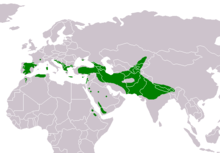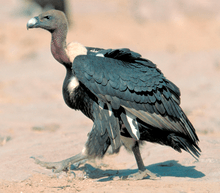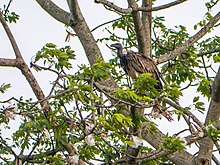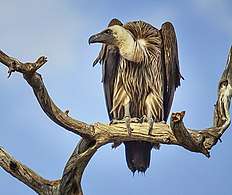Gyps
Gyps is a genus of Old World vultures that was proposed by Marie Jules César Savigny in 1809. Gyps vultures have a slim head, a long slender neck with downy feathers, and a ruff around the neck formed by long buoyant feathers. The crown of their big beaks is a little compressed, and their big dark nostrils are set transverse to the beak. They have six or seven wing feathers, of which the first is the shortest and the fourth the longest.[1] Gyps comprises the following species:
| Image | Name | Distribution and IUCN Red List status |
|---|---|---|
| Griffon vulture G. fulvus (Hablitz, 1783)[2] |  LC[3] | |
 | White-rumped vulture G. bengalensis (Gmelin, 1788)[4] | India CR[5] |
.jpg) | Cape vulture G. coprotheres (Forster, 1798)[6] | Southern Africa EN[7] |
 | Indian vulture G. indicus (Scopoli, 1786)[8] | Pakistan, India and Nepal CR[9] |
 | Slender-billed vulture G. tenuirostris Gray, 1844[10] | India CR[11] |
_(21160089681).jpg) | Rüppell's vulture G. ruppelli (Brehm, 1852)[12] | Sahel CR[13] |
 | White-backed vulture G. africanus Salvadori, 1865[14] | West and East Africa CR[15] |
.jpg) | Himalayan vulture G. himalayensis Hume, 1869[16] |  NT[17] |
| † Maltese vulture G. melitensis Lydekker, 1890[18] | Fossil remains were found in Middle to Late Pleistocene sites all over the central and eastern Mediterranean.[19] | |
| † G. bochenskii Boev, 2010 | Fossil remains were found near Varshets in northwestern Bulgaria that were dated to the Late Pliocene.[20] | |
| Gyps | |
|---|---|
| Scientific classification | |
| Kingdom: | Animalia |
| Phylum: | Chordata |
| Class: | Aves |
| Order: | Accipitriformes |
| Family: | Accipitridae |
| Subfamily: | Aegypiinae |
| Genus: | Gyps Savigny, 1809 |
References
- Savigny, M. J. C. (1809). "Gyps". Description de l'Égypte, ou recueil des observations et des recherches qui ont été faites en Égypte. I. Paris: L'Imprimerie Impériale. pp. 71–73.
- Hablitz, C. L. (1783). "Vultur fulvus Briss". Neue nordische Beyträge zur physikalischen und geographischen Erd- und Völkerbeschreibung, Naturgeschichte und Oekonomie. 4: 58–59.
- BirdLife International (2017). "Gyps fulvus". IUCN Red List of Threatened Species. 2017: e.T22695219A118593677.
- Gmelin, J. F. (1788). "Vultur bengalensis". Caroli a Linné, Systema naturae per regna tria naturae, secundum classes, ordines, genera, species, cum characteribus, differentiis, synonymis, locis. I (13th aucta, reformata ed.). Lipsiae: Georg Emanuel Beer. pp. 245–246.
- BirdLife International (2017). "Gyps bengalensis". IUCN Red List of Threatened Species. 2017: e.T22695194A118307773.
- Forster, J. R. (1798). "Le Chasse-siente, der Rothjäger. No. 10 (V. Coprotheres)". F. le Vaillant's Naturgeschichte der afrikanischen Vögel. Halle: Bey Fried. Christoph Dreyssig. pp. 35–37.
- BirdLife International (2015). "Gyps coprotheres". IUCN Red List of Threatened Species. 2015: e.T22695225A84339218.
- Scopoli, J. A. (1786–88). "Aves". Deliciae Flora et Fauna Insubricae Ticini. An account including new descriptions of the birds and mammals collected by Pierre Sonnerat on his voyages. London: C. J. Clay. pp. 7–18.
- BirdLife International (2017). "Gyps indicus". IUCN Red List of Threatened Species. 2017: e.T22729731A117875047.
- Gray, G.R. (1844). "Vulturinae, or Vultures". The genera of birds : comprising their generic characters, a notice of the habits of each genus, and an extensive list of species referred to their several genera. 1. London: Longman, Brown, Green, and Longmans. pp. 5–6.
- BirdLife International (2017). "Gyps tenuirostris". IUCN Red List of Threatened Species. 2017: e.T22729460A117367614.
- Brehm, A. (1852). "Beiträge zur Ornithologie Nord-Ost Afrikas, mit besonderer Rücksicht auf die in Europa vorkommenden Arten der Vögel". Naumannia. 2 (3): 38–51.
- BirdLife International (2017). "Gyps rueppelli". IUCN Red List of Threatened Species. 2017: e.T22695207A118595083.
- Salvadori, T. (1865). "Descrizione di una nuova species d'Avoltojo (Gyps africana)". Gazzetta Ufficiale del Regno d'Italia (126): 1.
- BirdLife International (2018). "Gyps africanus". IUCN Red List of Threatened Species. 2018: e.T22695189A126667006.
- Hume, A. O. H. (1869). "Gyps fulvus, Gmel. (Gyps himalayensis, nobis.)". My scrap book: or rough notes on Indian oology and ornithology. Calcutta: C.B. Lewis, Baptist Mission Press. pp. 12–18.
- BirdLife International (2016). "Gyps himalayensis". IUCN Red List of Threatened Species. 2016: e.T22695215A118594518.
- Lydekker, R. (1890). "On the remains of some large extinct birds from the cavern-deposits of Malta". Proceedings of the Zoological Society of London. 28 (III): 403–411.
- Marco, A. S. (2007). "New occurrences of the extinct vulture Gyps melitensis (Falconiformes, Aves) and a reappraisal of the paleospecies". Journal of Vertebrate Paleontology. 27 (4): 1057–1061.
- Boev, Z. (2010). "Gyps bochenskii sp. n. (Aves: Falconiformes) from the Late Pliocene of Varshets (NW Bulgaria)" (PDF). Acta Zoologica Bulgarica. 62 (2): 211–242.
External links
| Wikimedia Commons has media related to Gyps. |
This article is issued from Wikipedia. The text is licensed under Creative Commons - Attribution - Sharealike. Additional terms may apply for the media files.